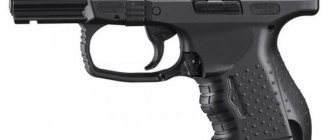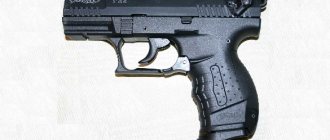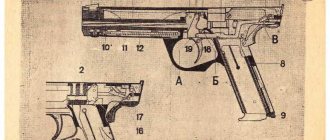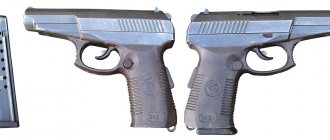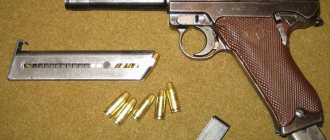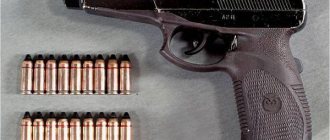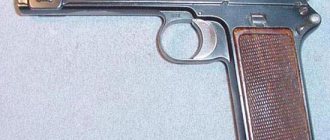Walter PP: what was the great-grandfather of the legendary PM like?
And its history began... no, not in 1929, when this model was put into production, but much earlier. Distinctive features of the pistol are the double-action trigger mechanism (the weapon is put into combat mode with one hand) and the operating principle - automatic based on the free movement of the bolt.
Experts consider the talented Czech gunsmith Alois Tomiska to be the founding father of this type of weapon. From 1900 to 1917, Alois Tomiska developed a pistol with a self-cocking trigger and several original solutions in the field of automatic short-barreled weapons, which he patented.
In 1919, he sold his patents to the Vienna Arms Factory, which, based on these developments, produced the original Little Tom pistol - the world's first mass-produced automatic pistol with a double-action trigger mechanism. This pistol attracted the attention of Fritz Walther, then head of Carl Walther GmbH, in 1924. It was the Little Tom creatively redesigned by German designers (the design was changed - the return spring under the barrel was replaced by a spring around the barrel (Browning's patent of 1897), and the replaceable magazine in the handle was equipped with a push-button latch - (Borchardt's patent of 1893) and became truly legendary, known throughout world.
The pistol was given the name Walther PP. Production of the new Polizei Pistole began in 1929.
The pistol was created according to a revolutionary design for that time - the movement of a free shutter. During the firing process, the cartridge case rolled back along with the bolt, was thrown out through a special window, and the spring returned the bolt back, feeding a new cartridge into the chamber. For reliable operation of such automation, only low-power cartridges were suitable, but even here the German gunsmiths, one might say, were unlucky.
Since at that time the production of weapons in Germany was limited by the terms of the Treaty of Versailles (barrel length no more than 100 mm, caliber no more than 8 mm), all the efforts of German weapons geniuses were aimed at creating weapons for low-power cartridges. And it was the free shutter circuit that was ideally suited to these conditions. Several versions of the Walther PP were released for different types of cartridges: .380 ACP (9 mm Browning “kurz” (short), .32 ACP (Browning 7.65 mm), .25 ACP (Browning 6.35 mm) and .22 LR ( 6.35 mm long rifle).
Tactical and technical characteristics
Walther RR (RRK) combat pistol.
The operating principle is blowback recoil, self-loading. Weight - 682 g/568 g. Weapon length 173 mm/155 mm. Barrel length - 99 mm / 86 mm. Sights - front and rear sights. Initial bullet speed (7.65 mm) - 290/280 m/s. Muzzle energy - 196/186 J. Food - box magazine with a capacity of 8/7 cartridges. Cartridge - 7.65 mm (.32 ACP), 9x17 mm (.38 ACP). .22 LR and 6.35 mm (.25 ACP). (Source: Wikipedia)
The successful model was constantly modernized, and in 1931 the more compact Walther PPK (Walther Polizei Pistole Kriminal) was released - a pistol for the criminal police, a smaller copy of the Walther PP for concealed carry. In addition to the reduction in size, PPK was distinguished by increased manufacturability, was more convenient, and easier to assemble and disassemble. The new handle design improved shooting accuracy even with a shorter barrel. Even despite the huge cost for those times (three times more expensive than the Parabellum pistol, and this is not a VIP version, but a regular “barrel”), the RRK model was more popular than the Walther PP.
In pre-war Germany, the Walther PP (PPK) was extremely popular. The popularity of the pistol reached the very top, the political and military elite of the German Wehrmacht. In those years, it was very “fashionable” to give party comrades VIP versions of Walther PP with original patterns and heroic mottos.
Before the start of World War II, each weapon was literally “licked”, which cannot be said about weapons released during the war. The quality of workmanship, of course, dropped somewhat, but overall the Walther PP continued to remain a compact and reliable weapon. For confident aiming at night, luminous marks were applied to the sighting devices. By the middle of the Second World War, the production of RR and RRK was practically ousted from German factories by orders for the Walther P38 army officer pistol, and after the end of the war, the victorious countries imposed a ban on the production of military weapons on Germany.
This ban did not last long. The German Democratic Republic resumed production of police Walters in 1947 from pre-war stockpiles of parts. Then the production of Walther PP clones began in Italy, France, Turkey, South Korea and Argentina. In addition to firearms, gas and pneumatic versions are available.
And the company Carl Walther Sportwaffen GmbH itself did not stand aside.
The RRK/S model of 1968 was the latest development among the Walther PP series pistols chambered for the powerful 9x19 mm cartridge. It used the most modern materials at that time, reducing the weight of the pistol by almost a quarter.
The successful model served as an example for weapons designers around the world to follow. Thus, the legendary Makarov pistol - PM - even looks like a police Walther. It’s not for nothing that in the West P M is called the “Russian Walter”.
A new wave of popularity for this pistol was brought by a series of film novels about James Bond, Agent 007. From the third to the eighteenth series, it was the Walther PP that was the main weapon of the “savior of the world.” And only in the nineteenth series the PP model was replaced by a new, more modern Walther P99. Walther RR also appeared in the films Indiana Jones and the Last Crusade, Die Hard, Lethal Weapon and many others.
Currently, Carl Walther Sportwaffen GmbH produces PPK, PPK/S and PPK/E models for the European and American weapons markets. Modifications of the pistol are available in two versions: “European” (the magazine is fixed by a spring at the bottom) and “American”, in which the magazine lock is located in the trigger area.
The 9 × 17 mm “kurz” (9 mm Browning Kurz) cartridges, for which most Walther RR clones are made, are produced in almost every country that generally produces ammunition.
Even today, in the 21st century, the Walther PPK is popular among intelligence officers around the world as a second, backup weapon, in addition to their service weapon.
I want to finish this article dedicated to this wonderful weapon with the words of Ian Fleming, author of the novels about Agent 007.
“I think it will suit 007. This is an effective weapon... In addition, cartridges for “Walter” are sold all over the world. What distinguishes it favorably from Russian and Japanese weapons.”
Tags: weapons, history of weapons, popularity, pistol, weapons
"Makarov", "Stechkin" and others
With regard to personal weapons, the experience of the Second World War, firstly, finally removed the revolver from the “army” arsenal, and secondly, left the pistol the role of an auxiliary weapon: in close combat, the submachine gun (automatic machine, as it was more often called then) turned out to be much more effective. , it was preferred by officers, tank crews, artillerymen, and drivers. The commander leading a unit into battle with a pistol in his hand went down in history, just like an infantry officer with a saber once did. On the battlefield and in the trenches, officers preferred a machine gun. A number of orders directly prescribed this to them. For example, the order for the troops of the 49th Army dated March 24, 1944 said: “During inspections of service in the first trench, all officers should have a machine gun and grenades with them.” The pistol retained its significance as a “peacetime weapon” for officers, a weapon for certain categories of soldiers and sergeants, and an auxiliary weapon for fighters in a number of specialties, especially in reconnaissance and sabotage units.
Experienced 7.65 mm pistol S.A. Korovin 1945
Almost immediately after the end of World War II, the “Third World War” began in the form of the “Cold War” (regularly turning into “hot” local wars and conflicts), which stimulated the rapid rearmament of the opposing sides. This also affected the small arms system. The experience of the war required its significant revision and updating. In the USSR, even after the war, the TT pistol continued to be produced, its last Soviet modification appeared in 1951 (in a number of countries - then allies - copies and modifications of the TT were produced later). But a new model was urgently needed. Moreover, domestic specialists had at their disposal a large number of different captured pistols chambered for various types of cartridges. Many of them were lighter and more compact than the TT, had a self-cocking trigger mechanism and a non-automatic safety. Coupled with extensive combat experience and familiarity with the enemy's weapons production, this provided a basis for the search.
In the armed forces - and they were the main customer - there was a desire to make the pistol more compact. Due to its good accuracy, the TT effectively hit unprotected targets at ranges of more than 25 m. Although for combat models the requirement for an aimed firing range of up to 50 m has been retained, personal weapons are more often used at ranges of up to 25 m. And here, in addition to accuracy, the stopping effect of the bullet is important (increasing caliber), speed of firing the first shot (introduction of self-cocking), reliability of operation (possible simplification of the design), safety of handling (fuses).
Experienced 7.65 mm pistol I.I. Rakova 1945
Experienced 9-mm pistol P.V. Vojvodina 1948
A competition for a new pistol to replace the TT was announced already in 1945. The GAU Small Arms Directorate formulated the task of developing a pistol with smaller weight and size characteristics, but with a bullet stopping effect at weapon ranges no less than that of the TT. At the same time, the assignment included calibers 7.62 (7.62×25 TT cartridge), 7.65 (7.65×17) and 9 mm (promising 9×18 cartridge). Well-known designers F.V. took part in the competition. Tokarev, P.V. Voevodin, S.A. Korovin, I.I. Rakov, S.G. Simonov, as well as young and still little-known N.F. Makarov and K.A. Baryshev from Tula, G.V. Sevryugin, A.A. Klimov and A.I. Lobanov from Izhevsk. Field tests of pistols of the Makarov, Sevryugin, Korovin, Rakov, Simonov, Baryshev, Voevodin systems began already in October 1945. At the scientific testing site for small arms and mortar weapons in Shchurovo (Moscow region), the pistols were thoroughly tested. For comparison, five foreign systems of compact pistols were tested - “Walter” RR, “Mauser” HSc, “Browning” 1922, “Sauer” 38N, “Beretta” 1934, as well as a TT pistol.
Success fell to the employee of TsKB-14 of the Ministry of Armaments N.F. Makarova. His main competitor at the final stage of the competition was the K.A. pistol. Barysheva. Tests of 9-mm pistol samples were carried out in 1948. Finally, the commission selected the 9-mm Makarov sample, which was adopted for service in 1951 under the designation PM (“Makarov pistol”). Along with the pistol, a pistol cartridge of the 9×18 type, developed by B.V., was also adopted. Semin and N.M. Elizarov at NII-44 (since 1949 he joined NII-61, subsequently the Central Research Institute of Precision Engineering). When developing a new pistol complex, the German RR pistol and the 9-mm Ultra pistol cartridge were taken as a basis. After the Great Patriotic War, a significant part of the Karl Walter production in Zella-Mehlis went to the Soviet side; specialists from the People's Commissariat (Ministry) of Armaments recommended focusing on the Walter systems when developing a new pistol. The prototype was chosen quite well, but it should be especially noted that neither the N.F. system pistol. Makarov, nor the new pistol cartridge were direct copies of German models. The design of the pistol was significantly redesigned in detail, and when developing the cartridge, it was necessary to take into account the existing machine equipment for TT cartridges. The introduction of the new cartridge into mass production was facilitated by the re-equipment of the domestic cartridge industry with new equipment (remember, for example, that with the beginning of the 1950s, L.N. Koshkin’s automatic rotary lines began to be widely introduced into cartridge production).
Experienced 9-mm pistol TKB-429 N.F. Makarova 1947
The blind designer M.V., who later became famous, also tried to develop his own version of a combat pistol. Margolin. The picture shows the experimental TKB-205 pistol he developed.
Organizing mass production of the new pistol took time, so until the early 1960s, when mass production of the PM was finally established, the TT pistol remained in service. However, in some military units the TT was found until the early 1990s, despite the large scale of PM production.
In the same 1951, the automatic pistol of another young employee of TsKB-14, I.Ya., was adopted for service. Stechkina. After accepting the intermediate cartridge arr. 1943 and the machine gun for it, the further development of submachine guns in our country was actually interrupted - they were returned to them much later and under different conditions. However, the need for compact automatic weapons remained. It could be useful to crews of combat vehicles, crews of heavy weapons, and motorcyclists. And so at the end of the 1940s. The idea of a pistol-carbine, popular in the late 19th and early 20th centuries, was uniquely revived in the form of automatic pistols and small-sized submachine guns with a folding or attached butt. Suffice it to remember that in those years the Czech “23” - “26” submachine guns by Kholek and the British MCEM-2 by Podsenkovsky appeared. In the USSR in the late 1940s. a number of small-sized submachine guns were also developed - for example, the 9-mm PPS-10-P-50 S.G. Simonov, submachine guns M.T. Kalashnikov 1947 (referred to as models 1 and 2), a compact folding submachine gun was developed at TsKB-14 N.F. Makarov and I.Ya. Stechkin. However, preference was given to an automatic pistol chambered for the same 9×18 cartridge.
Experienced pistol S.G. Simonova
Experienced automatic pistol P.V. Vojvodina - in a holster and with an attached holster-butt
Experienced automatic pistol M.T. Kalashnikov 1950 - in a holster and with an attached holster-butt
Designers from different generations took part in the competition for an automatic pistol (this was generally the time when a new generation of designers entered the arms business) - with experienced designer P.V. Young I.Ya. competed with Voevodin. Stechkin from Tula and M.T. Kalashnikov from Izhevsk. All presented automatic pistols were chambered for 9×18 cartridge, had automatic action based on blowback recoil and attached wooden butt holsters. Voevodin and Stechkin pistols had a trigger mechanism with the ability to fire by self-cocking, Kalashnikov - without self-cocking.
It is characteristic that automatic pistols were compared with the best automatic pistol of the 1930s. "Mauser"-712 ("Mauser-Astra") and the best submachine gun of the Second World War - PPS. The tactical and technical characteristics of the 9-mm automatic pistols submitted to the competition and the samples with which they were compared are presented in the table.
The 9-mm self-loading Makarov pistol (PM) and the Stechkin automatic pistol (APS), adopted for service in 1951, constituted a new generation of domestic military personal weapons
Despite being discontinued, the APS pistol continued to be used. And instructions on it were republished, as were instructions on PM. Characteristically, the manual on APS was reissued in 1984.
Note that the Stechkin automatic pistol is adopted in a version with a variable sight, designed for a firing range of up to 200 m, which corresponds to the aimed firing range of submachine guns (although the actual effective firing range from the APS is much lower).
Makarov and Stechkin pistols constituted a new generation of domestic personal weapons, and their adoption actually completed the formation of the first post-war small arms system, which included the AK assault rifle, SKS self-loading carbine, RPD light machine gun, SGM heavy machine gun, tank SGMT and armored personnel carrier SGMB, heavy machine guns DShKM, PKP and KPVT. The Izhevsk Mechanical Plant began organizing the production of the PM pistol back in 1949. The main advantages of the PM were its simplicity, compactness and exceptionally high reliability achieved in the process of mass production. It became the main personal weapon of the domestic armed forces for more than half a century. APS also showed good fighting qualities, but in the 1960s. was withdrawn from service and production - in fact, due to the inconvenience of a rigid holster-butt.
Standard setup for firing from PM. You can see the well-known combination of the stance preferred by athletes - sideways to the target, feet shoulder-width apart, the line of the shoulders almost coincides with the direction of the target - and shooting with the arm slightly bent at the elbow, which is usual for military weapons
Techniques for shooting from an APS with an attached holster-butt suggested in the manuals
Regarding potential adversaries, it can be noted that in 1953, within the framework of NATO, the 9x19 Parabellum cartridge (9x19 NATO) was standardized for pistols and submachine guns, which contributed to its further spread throughout the world. Foreign armies in the 1950s. A number of new pistols were adopted: M951 Beretta in Italy, MY950 MAS in France, Type 57 in Japan. The British Army limited itself to introducing 9-mm MI No. 2 in 1962, a modernized Browning High Power. In Germany, the newly created Bundeswehr was quite satisfied with the P1 pistol - a modernized version of the P.38 "Walter". During the same period, the needs of the “civilian” market gave rise to new revolver cartridges - in 1955, for example, the .44 Magnum appeared, which became one of the most popular revolver cartridges of the second half of the 20th century.
In the USSR, in the first two decades after the war, the main centers for the development of small arms, including personal weapons, were formed. Back in 1946, the Central Design Bureau of Sports and Hunting Weapons (TsKIB SOO) was formed in Tula, in which experimental design work was also actively carried out on military topics. In 1944, the Scientific Research Institute of Small Arms and Cannon Weapons of Aviation was formed, transformed in 1948 into NII-61, in 1949 it included NII-44 (development of cartridges for small arms), in 1957 a research department was formed and development of small arms. In 1961, on the basis of NII-61, the Central Research Institute of Precision Engineering (TSNIITOCHMASH) was organized in Klimovsk near Moscow, which became the leading enterprise of the industry in many areas of weapons, military and special equipment, including small arms and ammunition. The design team of the Izhevsk Mechanical Plant was also formed. Subsequently, all these groups were directly related to all areas of the development of personal weapons in our country.
Attempts were made to return to submachine guns in their small-sized version, close to automatic pistols. The photo shows an experimental 9-mm submachine gun PP-71 of the E.F. system. Dragunov (two decades later, the PP-91 Kedr would be created on this basis). However, the 9x18 PM cartridge turned out to be rather weak for this type of weapon
In law enforcement agencies, the pistol remained the main service weapon. And here, in addition to the PM, a new “cartridge-weapon” complex was also adopted. In 1969, an order was issued to develop a small-sized “pocket” type pistol for operational law enforcement officers. And in 1974, the 5.45-mm PSM pistol (“small-sized self-loading pistol”), developed at TsKIB SOO T.I., was adopted for service. Lashnev, A.A. Simarin and L.L. Kulikov for a new 5.45 mm pistol cartridge created at TsNIITOCHMASH by designer A.D. Denisova. Thus, another completely new pistol complex appeared, which entered service with the KGB and the Ministry of Internal Affairs, as well as senior command personnel.
Share link
MAKAROV PISTOL AND ITS DERIVATIVES
The PM, developed as a replacement for the Tokarev TT-33 pistol chambered for 7.62x25 mm, was adopted by the Soviet Union in 1951. The main goal when creating a new pistol was to provide easier control during frequent consecutive shots. Candidates participating in the competition held in the late 40s had to be lighter and more compact than the TT-33 pistol; they had to use a 7.62 mm or 9 mm cartridge as ammunition. Curiously, Soviet sources do not specify which cartridges were meant, but presumably the 7.62mm cartridge meant the standard 7.62x25mm, while the 9mm cartridge was the new 9x18mm. Makarov developed and submitted prototypes of both calibers to the competition, and his pistol chambered for 9x18 mm won.The PM is based on the Walter PP pistol of the mid-20s, but several significant improvements have been made to the design. First, the PM is equipped with an external slide stop, allowing the shooter to insert a new magazine and then release the bolt by simply pressing the slide stop; this operation can be performed with one hand. “Walter” required pulling the bolt back and releasing it, which is much more difficult to do, especially in battle. Secondly, the PM fuse works in the opposite way relative to the Walter design. The PP pistol is on safety if the lever is in the upper position; in order to remove it from the safety, you need to make an awkward movement with your thumb - raise it to the lever, and then lower the lever down. The PM is on safety if the lever is in the down position; Switching the pistol into combat mode is accomplished by simply moving your thumb forward. The only change in the design that causes complaints from users is the relocation of the magazine release latch from the rear of the trigger guard to the base of the handle, which makes it much more difficult to quickly change the magazine.
Another disadvantage of the PM is the ammunition. Although a simple metal-jacketed bullet from the 9x18 mm cartridge has better ballistic characteristics and has greater stopping power than a bullet from the 9x17 mm cartridge (.380 AKP), it is inferior in efficiency to the bullet from the 9x19 mm cartridge (Luger or Parabellum"). The 9x18mm cartridge is the most powerful cartridge used in pure blowback weapons, and at the same time the bullet does not have sufficient stopping power. Apparently, the Russian military came to the same conclusion some time ago, and the designers, solving the problem, took very interesting paths.
The first is that a new cartridge 57-H-181-M was developed for the PM, which retained the cartridge case from its predecessor, but gave the bullet an initial speed of 410 m/s instead of 315 m/s of the conventional 9x18 mm cartridge. Simple calculations show that although the new 9x19 mm cartridge, in terms of energy parameters, falls exactly in the region of the 9 mm Luger cartridge, however, for a pistol whose automation operates due to the energy of the free shutter, such a cartridge is too powerful. Russian gunsmiths solved this problem by cutting a spiral mark into the PM chamber, thus slowing down the movement of the free bolt. The new pistol can fire both regular and new ammunition. The 57-H-181-M cartridges differ in appearance in that the bullet has the shape of a truncated cone, while the old 57-N-181-S bullets had a rounded nose. Apparently, there is no method of protection that does not allow inserting a new “hot” cartridge into an old PM pistol, which, naturally, will not withstand the increased pressure in the barrel and the increased shutter speed and will fail after a few shots. Russian sources claim that the new cartridge has exactly the same dimensions as the old one, which, undoubtedly, should create certain problems for the Russian military and police, who are armed with pistols chambered for both the old and the new 9x19 mm cartridges. At the time of writing this book, there are reports that Russia has created several pistols and submachine guns chambered for the 7.56 2x19mm Parabellum cartridge. This indicates that the Russians were not satisfied with the completely new 9x18mm cartridge, which has increased momentum.
PMM-8 pistol chambered for 9×18 mm.
PMM-12 pistol chambered for 9×18 mm with a magazine for 12 rounds.
The new blowback pistol with a delay received the designation PMM (“modernized Makarov pistol”). This is not just a PM pistol with a spiral notch in the chamber. In addition to the new, more powerful ammunition, the 9x18 mm PMM is equipped with an increased capacity magazine for 12 rounds with a double-stack arrangement. This modification has the official designation PMM-12. There is also a modification with a magazine capacity of 8 rounds. It is designated PMM. Both pistols are approximately 5 percent larger than the base PM model. Russian reference books primarily describe a modification with a magazine capacity of 12 rounds, which is apparently more common. This model is described simply as a PMM, so in the future we will use this designation to describe a pistol with an increased magazine capacity.
The Russians directly compare the PMM and its improved 9x18mm ammunition to Western pistols chambered for the 9x19mm cartridge, such as Glock, SIG, Smith & Wesson, and Heckler & Koch compacts. Russian sources indicate that the PMM has ballistic characteristics equal to or superior to those of most 9x19mm iodine pistols, but the reduced size of the ammunition means less recoil and less weight. Such a comparison is quite justified; The PMM is a cheaper, competitive competitor to Western pistols of the same size. The Russians, seeing the prospect of the PMM moving into Western markets, prepared to import its gender under the designation "Baikal-442" into the United States, but the Clinton administration banned the import of Makarov pistols.
However, the modification of the Baikal-442 PMM pistol, intended for delivery to the United States, was made not for the new 9x18 mm cartridge, but for the 9 mm Luger cartridge. The force of the powder gases produced when the 57-H-18I-M cartridge is fired is comparable to that produced by a 9 mm Luger; modifying the PMM for a longer (only 4 mm) 9 mm Luger cartridge did not present any engineering difficulties. The appearance of the Baikal-442 pistol clearly shows that it was intended for import to the United States. The pistol is equipped with an adjustable sight and has a higher quality finish compared to its predecessors. The Baikal-442 is also slightly larger than the PMM produced for use inside Russia, this is done in order to bring it into line with American weapons import standards. "Baikal-442" is still produced on, but, unfortunately, is not supplied to the United States.
It is likely that the PMM will eventually replace the old PM in service with the Russian army and police, since it has significant advantages over its predecessor. Moreover, the fact that old pistols can accidentally fire new powerful cartridges creates an obvious problem, which can be solved by completely switching to PMM. The new pistol has been in mass production since January 1994 and is intended to replace the PM in military service.
The latest modification of the Makarov PMM OTs-35 is produced by the Tula KBP. OTs-35 is a PMM Makarov pistol with a recoil compensator mounted on the muzzle. Tula sources claim that the purpose of installing a compensator is to increase accuracy and hit probability by reducing upward muzzle lift, especially when firing the more powerful 57-N-181-M cartridge. The weight increase compared to the basic PMM model is insignificant; The compensator increases the overall length of the gun by an additional 18 mm.
OTs-35 is a Makarov pistol equipped with a compensator.
CHARACTERISTICS PMM (PM)
Caliber 9×18 mm increased power (9×18 mm)
Automatic operating principle: blowback with delay (blowback), semi-automatic
Weight 0.76 kg (0.68 kg)
Length 167 mm (161 mm)
Barrel length 93.5 mm
Effective shot range 25 m
Magazine capacity 12 rounds or 8 rounds
Front sight sighting device; rear sight with slot, adjustable to compensate for side winds
Table of contents
